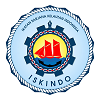PREFERENSI HABITAT SPESIES OPHIUROIDEA DI ZONA INTERTIDAL PANTAI PANCUR TAMAN NASIONAL ALAS PURWO
Abstract
Karakteristik zona intertidal Pantai Pancur Taman Nasional Alas Purwo berupa paparan karang mati, bebatuan, area lamun, dan area makroalga. Kondisi habitat yang heterogen ini menarik untuk diteliti, terutama dalam rangka memahami preferensi habitat populasi spesies Ophiuroidea yang ada, dengan posisi pantai yang menghadap laut lepas Samudera Hindia yang dikenal bergelombang tinggi dan berarus deras. Untuk menentukan relung yang dipilih tiap populasi Ophiuroidea, dilakukan metode road sampling dengan cara ‘tracking’ tipe-tipe habitat dengan GPS sehingga bisa dipetakan dalam peta tematik. Di atas peta ini, kemudian di gambarkan posisi (dengan GPS) tiap individu Ophiuroidea yang ditemukan. Penggambaran peta sebaran tersebut menggunakan program ArcGIS 9.3. Persebaran Ophiuroidea di wilayah Pantai Pancur tidak merata dan cenderung mengelompok pada wilayah yang terdapat substrat batu berpasir, area alga, dan area lamun. Ophiocoma scolopendrina merupakan spesies yang dominan ditemukan di Pantai Pancur dan menempati area yang paling luas dibandingkan spesies yang lain. Macrophiothrix longipeda adalah spesies yang menempati area paling sempit. Berdasarkan hasil overlay peta persebaran alga dan lamun di Pantai Pancur, Ophiuroidea menempati wilayah bersama pada substrat batu berpasir dengan area lamun dan alga Area. O. brevipes, O. annulosa, dan M. longipeda ditemukan tidak bersinggungan saat penelitian. Ini menunjukkan salah satu strategi berbagi ruang.
Kata Kunci: Ophiuroidea, Pantai Pancur, Taman Nasional Alas Purwo
ABSTRACT
Characteristics of Intertidal zone Pancur Coastal Alas Purwo National Park has dead coral, bed rock, seagrass, and seaweed. This heterogeneous habitat condition is interesting to study, especially in order to understand the habitat preferences of the existing Ophiuroidea species population, with the position of the beach facing the sea off the Indian Ocean which is known to be high wave and swift flow. For determine the niche chosen by each Ophiuroidea population, the road sampling method is carried out by means of 'tracking' habitat types with GPS so that they can be mapped on thematic maps. On this map, then describe the position (with GPS) of each Ophiuroidea individual found. The depiction of the distribution map uses the ArcGIS 9.3 program. The distribution of Ophiuroidea in the Pancur Beach area is uneven and tends to cluster in areas with sandy stone substrates, algae areas, and seagrass areas. Ophiocoma scolopendrina is the dominant species found on Pancur Beach and occupies the most extensive area compared to other species. Macrophiothrix longipeda is a species that occupies the narrowest area. Based on the results of overlaying maps of algae and seagrass distribution in Pancur Beach, Ophiuroidea occupied a shared area on sandy rock substrate with seagrass areas and seaweed Area Ophiocoma brevipes, Ophiomastix annulosa, and M. longipeda found not intersecting during the study. This shows one of the space sharing strategies.
Keywords: Ophiuroidea, Pancur Coast, Alas Purwo National Park
Full Text:
PDF (Bahasa Indonesia)References
Appeltans W, Stohr S, O’Hara T. (2009). World Ophiuroidea Database. [Internet]. [diunduh 2017 Maret 9]. Tersedia pada: http://marinespecies.org.
Aronson, R. B. (1988). Palatability of five Caribbean ophiuroids. Bulletin of marine science, 43(1), 93-97.
Atmadja WS. (1986). Kolonisasi dan suksesi pada alga laut bentik. Oseana, 11,1-10.
Atmadja WS, Kadi A, Sulistijo, Satari R. (1997). Pengenalan Jenis-Jenis Rumput Laut Indonesia. Jakarta (ID): Puslitbang Oseanografi LIPI.
Azis MF. 2006. Gerak air di laut. Oseana, 21, 9-21.
Aziz A, Sugiarto H. (1994). Fauna Ekhinodermata Padang Lamun di Pantai Lombok Selatan. Jakarta (ID): Puslitbang LIPI P2O.
Aziz A. (1995). Beberapa catatan tentang bintang mengular (Ophiuroidea) sebagai biota bentik. Oseana,16, 13-22.
Aziz A, Al Hakim II. (2007). Fauna ekhinodermata perairan terumbu karang sekitar Bakauheni. Oseanologi dan Limnologi Indonesia, 33, 187-198.
Azkab MH. (1999). Pedoman inventarisasi lamun. Oseana, 24, 1-16.
[BTNAP] Balai Taman Nasional Alas Purwo. (2016). Buku Informasi Balai Taman Nasional Alas Purwo. Banyuwangi (ID): Balai Taman Nasional Alas Purwo.
Bookhout TA. (1996). Research And Management Techniques For Wildlife And Habitats. Kansas (US): Allen Press Inc.
Borowitzka MA. (1972). Intertidal algae species diversity and the effect of pollution. Aust J mar Fresw Res, 23, 73 -84.
Brusca RC, Brusca GJ. 2003. Invertebrates. 2nd Edition. New York (US): Sinauer Associates.
Bussarawit S, Rowe FWE. (1984). A new spesies in the ophiocomid Genus Ophiocoma (Echinodermata: Ophiuroidea) from the West Coast of Thailand, Andaman Sea. Research Bulletin, 35, 1-6.
Castro P, Huber ME. (2007). Marine Biology. Seventh Edition. New York (US): McGraw Hill.
Chinn S. (2006). Habitat distribution and comparison of brittle star (Echinodermata: Ophiuroidea) arm regeneration on Moorea, French Polynesia. Biology and Geomorphology of Tropical Islands, 12, 1-11.
Clark AH. (1949). Ophiuroidea of the Hawaiian Islands. Honolulu (US): Bernice P. Bishop Museum Bulletin.
Clark AM, Rowe FWE. (1971). Monograph of Indo West Pacific Echinoderms. London (UK): British Museum of Natural History.
Devaney DM. (1974). Shallow water asterozoans of Southeastern Polynesia (Ophiuroidea). Micronesia, 10, 105-204.
Devaney DM. 1978. A review of the Genus Ophiomastix (Ophiurida: Ophiocomidae). Micronesia,14, 273-359.
Duffy JE, Hay ME. (1994). Herbivore resistance to seaweed chemical defense; the roles of mobility and predation risk. Ecology, 75, 1304-1319.
Fourgon D, Lepoint G, Eeckhaut I. (2003). Assessment of trophic relationships between symbiotic tropical Ophiuroids using C and N stable isotope analysis. Invertebrates Biology, 12, 1-8.
Fourgon D, Jangoux M, Eeckhaut I. (2007). Biology of a ‘‘babysitting’’ symbiosis in brittle stars: analysis of the interactions between Ophiomastix venosa and Ophiocoma scolopendrina. Invertebrates Biology, 126, 385-395.
Gage JD, Tyler PA. (2002). Deep Sea Biology: A Natural History of Organism at the Deep Sea Floor. Cambridge (UK) : Cambridge University Press.
Guille A, Wolff WJ. (1984). Zoologische Verhandelingen: Resultats Biologiques De L’expedition Snellius Echinodermata (Ophiuroidea). Leiden (ND): Drukkerij Griethoorn.
Hendler, G. (1984). Brittlestar Color‐Change and Phototaxis (Echinodermata: Ophiuroidea: Ophiocomidae). Marine Ecology, 5(4), 379-401.
Hendler G, Grygier MJ, Maldonado E, Denton J. (1999). Babysitting brittle stars: heterospesific symbiosis between ophiuroids (Echinodermata). Invertebrate Biology, 118, 190-201.
Henkel TP, Pawlik JR. (2005). Habitat use by sponge-dwelling brittlestars. Marine Biology, 146, 301-313.
Ilahude AG, Nontji A. (1999). Oseanografi Indonesia dan Perubahan iklim Global (El Nino dan La Nina). Jakarta (ID): Oseanografi LIPI.
James DB. (1982). Ecology of intertidal Echinoderms of the Indian Seas. J Mar Bio Ass India, 24, 124-129.
Keshavarz M, Mohamamdikia D, Dabbagh AR. (2012). The Echinoderms fauna in intertidal zone of Southerns Oli Village Coast. J Anim Sci Adv, 2, 495-498.
Krebs JC. (1989). Ecological Methodology. New York (US): Harper Collins Publishers.
Krebs JC. (1993). Ecology: The Experimental Analysis of Distribution and Abundance. New York (US): Harper Collins Publishers.
Laurent, L. S., Stringer, S., Garrett, C., & Perrault-Joncas, D. (2003). The generation of internal tides at abrupt topography. Deep Sea Research Part I: Oceanographic Research Papers, 50(8), 987-1003.
Lawrence J. (1987). A Functional Biology of Echinoderms. Baltimore (US): The Johns Hopkins University Press.
Levinton JS. (1982). Marine Ecology. New Jersey (US): Prentice-Hall Inc.
Maluf LY. (1988). Composition and Distribution of the Central Eastern Pacific Echinoderms. Los Angeles (US): National History Museum of Los Angeles Country.
Martin, I. N., Anker, A., Britayev, T. A., & Palmer, A. R. (2005). Symbiosis between the alpheid shrimp, Athanas ornithorhynchus Banner and Banner, 1973 (Crustacea: Decapoda), and the brittle star, Macrophiothrix longipeda (Lamarck, 1816)(Echinodermata: Ophiuroidea). Zoological Studies-Taipei-, 44(2), 234.
Martynov, A. V., & Litvinova, N. M. (2008). Deep-water Ophiuroidea of the northern Atlantic with descriptions of three new species and taxonomic remarks on certain genera and species. Marine Biology Research, 4(1-2), 76-111.
McClintock, J. B. (1994). Trophic biology of Antarctic shallow-water echinoderms.
Marine ecology progress series. Oldendorf, 111(1), 191-202.
Minarputri, N., Moehammadi, N., & Irawan, B. (2012). The Profile of Bama Beach Based on The Substrate, The Presence of Seagrass, Coral Lifeform, and Echinodermata. Jurnal Berkala Penelitian Hayati, 17.
Mortensen TH. (1933). Echinoderms of South Africa (Asteroidea and Ophiuroidea). Vidensk Medd Fra Danks Naturh Foren, 65, 215-400.
Murakami S. (1943a). Report on the Ophiurans of Palao, Caroline Island. Journal of the Department of Agriculture, 7, 159-204.
Murakami S. (1943b). Report on the Ophiurans of Yaeyama, Ryukyu. Journal of the Department of Agriculture, 7, 205-222.
Murakami S. (1943c). Ophiurans from some gulfs and bays of Nippon. Journal of the Department of Agriculture, 7, 223-234.
Nybakken JW. (1993). Marine Biology. Third Edition. New York (US): R.R Donnelley & Sons Company.
Oak, T., & Scheibling, R. E. (2006). Tidal activity pattern and feeding behaviour of the ophiuroid Ophiocoma scolopendrina on a Kenyan reef flat. Coral Reefs, 25(2), 213-222.
Odum E. (1993). Dasar-Dasar Ekologi. Edisi Ketiga. Yogyakarta (ID): Gadjah Mada University Press.
Olbers, J., & Samyn, Y. (2012). The Ophiocoma species (Ophiurida: Ophiocomidae) of South Africa. Western Indian Ocean Journal of Marine Science, 10, 137-154.
Pecherik JA. (2005). Biology of the Invertebrates. Fifth edition. New York (US): Wm. C. Brown Publishers.
Pomory, C. M. (2007). Key to the common shallow-water brittle stars (Echinodermata: Ophiuroidea) of the Gulf of Mexico and Caribbean Sea. Caribbean Journal of Science, 10, 1-42.
Purwati P. (2006). Teripang, Biodiversitas, dan Permasalahan di Indonesia. Laporan Akhir Tahunan. Jakarta (ID): Program Penelitian dan Pengembangan IPTEK, Riset Kompetitif LIPI.
Purwati P, Syahailatua A. (2008). Timun Laut Lombok Barat. Jakarta (ID): Ikatan Sarjana Oseanologi Indonesia.
Sadhukhan, K., & Raghunathan, C. (2012). A study on diversity and distribution of reef associated Echinoderm fauna in South Andaman, India. Asian J. of experimental biological association, 3, 187-196.
Benavides-Serrato, M. I. L. E. N. A., & O’Hara, T. D. (2008). A new species in the Ophiocoma erinaceus complex from the South-west Pacific Ocean (Echinodermata: Ophiuroidea: Ophiocomidae). Memoirs of Museum Victoria, 65, 51-56.
Siswoyo, M. P. (2009). Pasir Pantai Selatan Jawa Timur Dalam Mortar. Jurnal Teknik Sipil dan Perencanaan, 11(2), 109-120.
Soong, K. Y., Shen, Y., Tseng, S. H., & Chen, C. P. (1997). Regeneration and potential functional differentiation of arms in the brittlestar, Ophiocoma scolopendrina(Lamarck)(Echinodermata: Ophiuroidea). Zoological Studies, 36(2), 90-97.
Stohr S, Segonzac M. (2004). Deep-sea Ophiuroids (Echinodermata) from reducing and non-reducing environments in the North Atlantic Ocean. J Mar Biol Ass U.K, 84, 1-20.
Stohr S, O’hara TD, Thuy B. (2012). Global diversity of brittle stars (Echinodermata: Ophiuroidea). Plos One, 7, 1-14.
Sugiarto H. (2006). Fauna Ekhinodermata di Perairan Kabaena, Muna, dan Buton Sulawesi Tenggara. Warta Oseanografi, 20, 27-31.
Tran JK, Whited B. (2004). Patterns of distribution of three brittlestar species (Echinodermata: Ophiuroidea) on Coral Reefs. Discovery Bay, 1, 177-180.
Tubalawony S. (2007). Kajian Klorofil-A dan Nutrien serta Interelasinya dengan Dinamika Massa Air di Perairan Barat Sumatera dan Selatan Jawa-Sumatera [disertasi]. Bogor (ID): Institut Pertanian Bogor.
Viaroli, P., Bartoli, M., Giordani, G., Magni, P., & Welsh, D. T. (2004). Biogeochemical indicators as tools for assessing sediment quality/vulnerability in transitional aquatic ecosystems. Aquatic Conservation: Marine and Freshwater Ecosystems, 14(S1), S19-S29.
Viejo, R. M. (1999). Mobile epifauna inhabiting the invasive Sargassum muticum and two local seaweeds in northern Spain. Aquatic botany, 64(2), 131-149.
West EA. (2012). Adaptive regeneration of Ophiocoma Scolopendrina (Echinodermata: Ophiuroidea) under two feeding treatments in Moorea, French Polynesia. Biology and Geomorphology of Tropical Islands, 12, 1-11.
Yusron E. (2003). Beberapa catatan fauna Ekhinodermata dari Perairan Tapak Tuan, Aceh Selatan, Nanggroe Aceh Darussalam. Makara Sains, 7, 97-104.
Yusron E. (2006a). Biodiversitas Ekhinodermata di Perairan Pantai Takofi, Pulau Moti Maluku Utara. Makara Sains, 10, 41-46.
Yusron E. (2006b). Keanekaragaman Ekhinodermata di Perairan Morotai bagian selatan Maluku Selatan. Oseana, 31, 13-20.
Yusron E. (2009a). Biodiversitas Fauna Ekhinodermata dari Perairan Selat Lembeh Bitung Sulawesi Utara. J Oldi, 35, 217-229.
Yusron E. (2009b). Keanekaragaman jenis Ekhinodermata di Perairan Teluk Kuta, Nusa Tenggara Barat. Makara Sains, 13, 45-49.
Yusron E. (2010a). Keanekaragaman jenis Ophiuroidea (Bintang Mengular) di Perairan Wori, Minahasa Utara, Sulawesi Utara. Makara Sains, 14, 75-78.
Yusron E. (2010b). Keanekaragaman jenis Ekhinodermata di Perairan Likupang, Minahasa Utara, Sulawesi Utara. Ilmu Kelautan, 15, 85-90.
Yusron E, Susetiono. (2010). Diversitas fauna Ekhinodermata di Perairan Ternate, Maluku Utara. J Oldi, 36, 293-307.
DOI: https://doi.org/10.21107/jk.v11i2.4741
Refbacks
- There are currently no refbacks.

This work is licensed under a Creative Commons Attribution 4.0 International License.

Jurnal Kelautan by Program Studi Ilmu Kelautan is licensed under a Creative Commons Attribution 4.0 International License.
Published by: Department of Marine Sciences, Trunojoyo University of Madura













